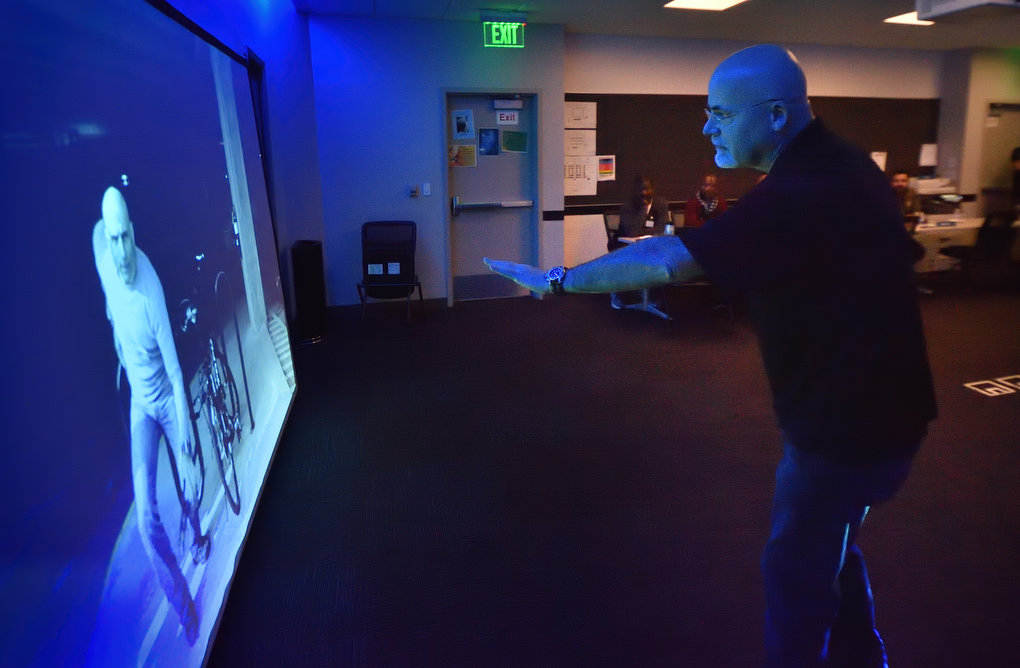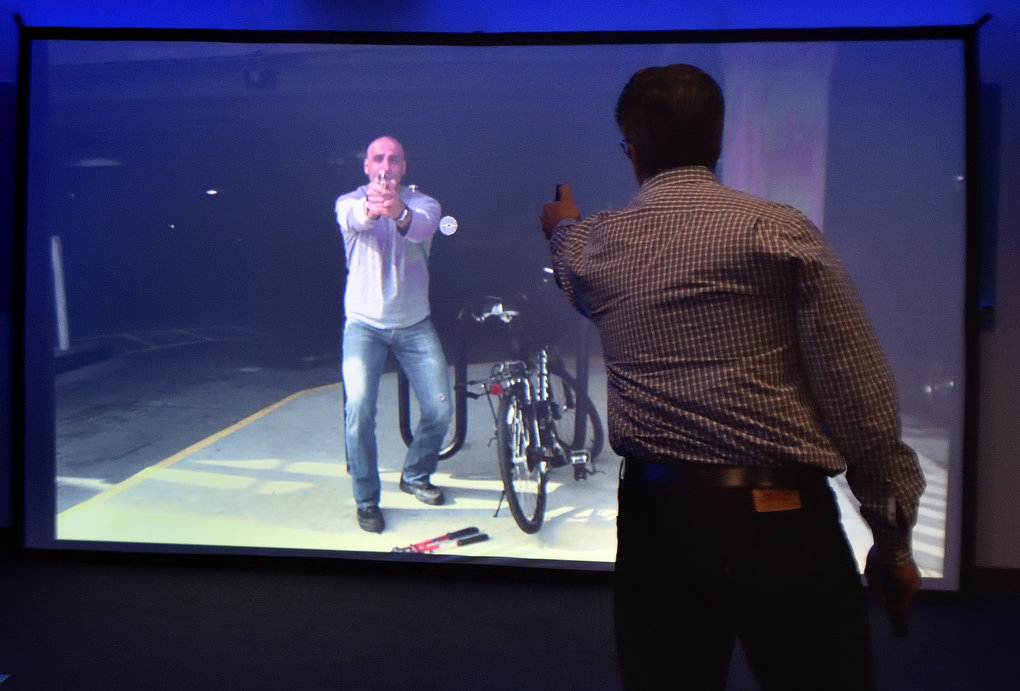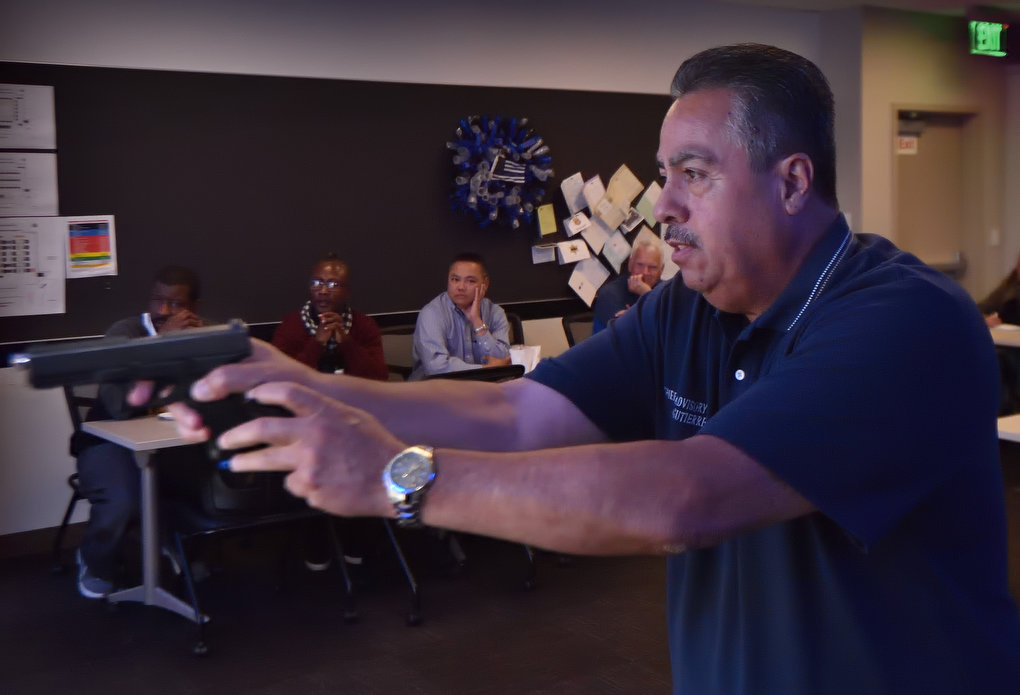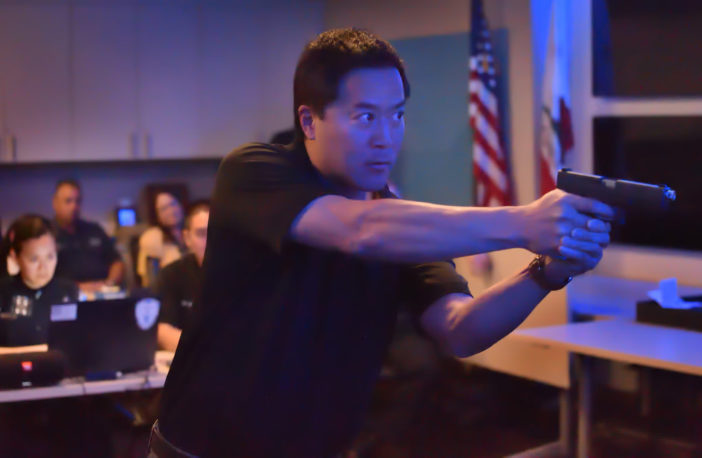While on foot patrol at the Metrolink station, officers discover a man near a bicycle holding bolt cutters. The area is known for thefts of vehicles and bikes.
“Can I see some ID?” one “officer” asks.
The suspect does not comply with the “officer’s” commands, will not put down the bolt cutters and is verbally uncooperative. After hearing several verbal commands, the suspect starts to put the bolt cutters on the ground but then reaches behind his back, pulling out a gun. The officers fire their guns, and the suspect is shot down.

Tustin PD Chief’s Advisory Board member Garry Heath talks to the actor on the screen as he tries to defuse the situation as simulation operators behind him (not pictured) direct the actions of the simulation.
Photo by Steven Georges/Behind the Badge OC
The scenario was part of a new Tustin Police Department use-of-force simulator that allows officers to train for real-life situations they may face while on patrol. The simulator also will be used as an educational tool for the community. Members of the Tustin PD Chief’s Advisory Board were able to experience the simulator at their March 21 meeting.
“It’s definitely a life-like scenario that is eye-opening,” said Chief Advisory Board member Mike Geyer, who shot the suspect twice during his simulation. “It gets really scary.”

Tustin PD Officer Dave Nguyen describes how to use the simulator for the Tustin PD Chief’s Advisory Board before getting their turn to run through the same shooting simulations that officers use in training.
Photo by Steven Georges/Behind the Badge OC
Alone or in pairs, several Advisory Board members volunteered to experience an interactive scenario, which was projected on a large screen in a Tustin PD conference room. Participants were given simulation guns and pepper spray. Both tools are real but were gutted and retooled using system components to work with the simulator. The suspect on the screen responds to being shot, and the guns have actual recoil for realism.
“This is another piece of equipment that helps our officers train,” Sgt. Duane Havourd, Tustin PD’s range and simulator staff supervisor, told the board. “It’s a type of stress inoculation… It helps your decision-making process.”

Tustin PD Chief’s Advisory Board member Mike Guyer pulls his weapon at the screen as Tustin PD Officers Dave Nguyen, left, and Natalie Nguyen guide the reactions of the simulation.
Photo by Steven Georges/Behind the Badge OC
Board members experienced for themselves how quickly those decisions have to be made.
“We try to make it as realistic as possible,” Det. David Nguyen, a member of the range and simulator staff, told board members while giving them instructions for the simulation. He added that while the simulator is realistic, is still doesn’t account for the real stressors officers may face in the field. “I want you guys to keep in mind, you’re sitting back here – no stress.”
The Chief’s Advisory Board members were a mixed bag in terms of the end result of the simulation. Some shot the suspect, others were shot themselves, and one used the pepper spray instead of the gun, to his detriment. When replayed, the recorded scenario displayed where the shots landed. The board members experienced only one of more than 700 scenarios available in the simulator, offering them a glimpse of a patrol officer’s experiences in the field.

Bill McInerney reacts by pointing his simulation gun at a special screen with sensors as the actor on the screen pulls out his gun during a shooting simulation session for Tustin PD Chief’s Advisory Board members.
Photo by Steven Georges/Behind the Badge OC
After each participant went through the 2-minute scenario, Nguyen ran each person through a debrief of what had transpired.
“Is he complying or not complying?” Nguyen asked two participants.
“Not complying,” one answered.
Nguyen said these are the types of questions officers need to answer as well.
“These are things that you would have to articulate in your police report,” he said.

Tustin PD Chief’s Advisory Board members Chris Cusac and AJ Jha, right, try their hand at the shooting simulator as other board members watch.
Photo by Steven Georges/Behind the Badge OC
He explained to the board members the challenges officers face in these kinds of situations.
“Action is always faster than reaction,” Nguyen said, meaning a suspect pulling out a gun is the action and the officer must react. “If you’re too early, you get scrutinized. If you’re too late, you’re dead.”

Al Gutierrez holds up a simulation gun with realistic kickback action as he and others from the Tustin PD Chief’s Advisory Board, runs through a shooting simulator.
Photo by Steven Georges/Behind the Badge OC
At the end of the meeting, all the “officers” expressed their thankfulness for the opportunity to participate in the experience. And although the demonstrations were just simulations, they understood the scenarios were realistic. The board members said the job of a police officer is a difficult one and the need to make a decision in a split second is something that is easy to critique, but difficult to experience.
 Behind the Badge
Behind the Badge



